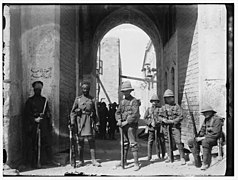Lions' Gate
| Lions' Gate | |
|---|---|
 Lions' Gate | |
 Location in Old Jerusalem | |
| Alternative names | St Stephen's Gate, Bab Sitti Maryam (lit. 'Gate of My Lady Mary') |
| General information | |
| Town or city | Jerusalem Old City, Muslim Quarter |
| Coordinates | 31°46′51″N 35°14′13″E / 31.78083°N 35.23694°ECoordinates: 31°46′51″N 35°14′13″E / 31.78083°N 35.23694°E |
| Completed | 1538/9 (AH 945)[1] |
| Renovated | 2012[2] |
| Dimensions | |
| Other dimensions | Height: 13.7 m (45 ft)[3] |
Lions' Gate (Hebrew: שער האריות, romanized: Sha'ar ha-Arayot, lit. 'Lions' Gate', Arabic: باب الأسباط, romanized: Bab al-Asbat, lit. 'Gate of the Tribes'), also St Stephen's Gate, is one of the Gates of the Old City of Jerusalem. It is one of seven open gates in the Old City walls. It is associated with the ancient Sheep Gate.
History[]
The start of the traditional Christian observance of the last walk of Jesus from prison to crucifixion, the Via Dolorosa begins at the Lions' Gate. Carved into the wall above the gate are four lions, two on the left and two on the right. Suleiman the Magnificent had the carving made to celebrate the Ottoman defeat of the Mamluks in 1517. Legend has it that Suleiman's predecessor Selim I dreamed of lions that were going to eat him because of his plans to level the city. He was spared only after promising to protect the city by building a wall around it. This led to the lion becoming the heraldic symbol of Jerusalem.[4][dubious ]
Historian Moshe Sharon notes the similarity of the sculpted felines to similar pairs at Jisr Jindas and Qasr al-Basha in Gaza. All represent the same Mamluk sultan, Baybars. Sharon estimates that they all date to approximately 1273 C.E.[5]
The gate is part of the city's extant walls, built by Ottoman Sultan Suleiman in 1538. The walls stretch for approximately 4.5 kilometers (2.8 mi) and rise to a height of 5–15 meters (16–49 ft), with a thickness of 3 meters (9.8 feet).[6] All together, the Old City walls contain 43 surveillance towers and 11 gates, seven of which are presently open.

British imperial troops from India and Britain guard the gate in 1920
References[]
- ^ "Jerusalem within the Walls". Ministry of Foreign Affairs. 11 September 2012. Retrieved 10 January 2022.
- ^ "Conservation work at the Lions Gate completed". Ministry of Foreign Affairs (Israel). 11 September 2012. Retrieved 10 January 2022.
- ^ Conservation of the Lions Gate Section, Israel Antiquities Authority, 2012, retrieved 10 January 2022
- ^ a b Murphy-O'Connor, Jerome, The Holy Land: an Oxford archaeological guide from earliest times to 1700, 2008, p. 21, ISBN 978-0-19-923666-4
- ^ Sharon, 2009, p. 58 and pl. 6.
- ^ The Jerusalem Post Millennium Special Archived 2007-04-29 at the Wayback Machine
- ^ Jerusalem municipality website Archived 2011-06-17 at the Wayback Machine
Bibliography[]
- Sharon, Moshe (2009). Corpus Inscriptionum Arabicarum Palaestinae, G. Vol. 4. BRILL. ISBN 978-90-04-17085-8.
External links[]
| Wikimedia Commons has media related to Lions Gate. |
- The Old City Gates: www.jewishvirtuallibrary.org Archived 2016-11-29 at the Wayback Machine
- Gates in Jerusalem's Old City Walls



